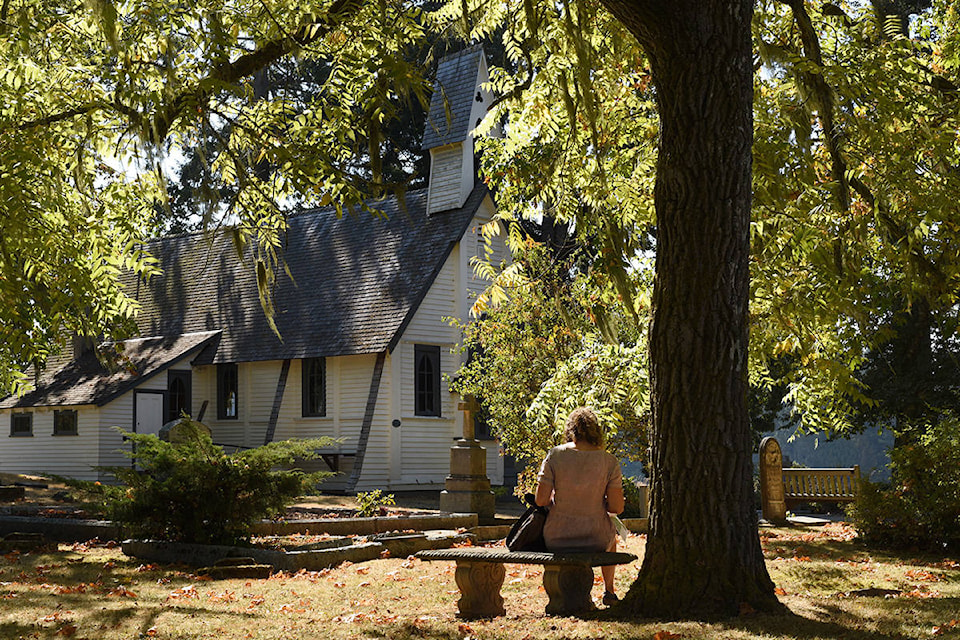Story by Hans Tammemagi
Many say the soul of a community is its church, but the beating pulse is the local tavern. This certainly seemed true for the Prairie Inn— prominently located on the intersection of Mount Newton Cross Road and East Saanich Road in Saanichton—for though I visited midweek, business was brisk.
Andrea Pickard, a friend interested in local history, and I were sitting at the well-worn bar, studying a pamphlet that described a Heritage Walk along Mount Newton Cross Road. Keen to learn about Central Saanich’s past, we were at the tour’s first designated stop. There was one catch: the brochure was more than three decades old. Was it still current? What would we find?
We chatted with the barkeeper, who explained that the pub was built in 1859 for Henry Simpson, an early pioneer in the area. Called the Tavern, it was one of the first pubs in the province. The Tavern burned down in 1893 and was rebuilt as the Prairie Inn.
Pouring us an ale, the bartender listed the inn’s many historic achievements.
“If you don’t count the brief stoppage while it was rebuilt, this is the oldest continuously operating pub in British Columbia.”
“Furthermore,” he continued proudly, “we started brewing beer — the bestseller was Olde Tavern Ale — in 1985, as [one of the] first brewpubs on Vancouver Island.”
Sadly, the brewery part of the operation was discontinued more than 25 years ago. But later, we learned that in 1974 the Prairie Inn received the province’s first official designation as a “neighbourhood pub.” We sipped our ale in reverence, happy to be in such historic surroundings.
| The Prairie Inn, open since 1859. Don Denton photography |
As we started westward along Mount Newton Cross Road, we read from our notes that Henry Simpson, the original owner of the Prairie Inn, was one of the first pioneers in this area. He ran a large farm and was a prime initiator of the annual Saanich Fair, even donating five acres of land to get it started. As we were to learn later, he was a flamboyant gent, who dabbled in many exciting businesses.
After a few hundred metres, we were immersed in rich farming land; the agricultural character of the landscape was clearly evident.
Glancing at our literature as we strolled, we learned that the original inhabitants of this area were the Saanich First Nations, who lived off the bounty of the land and sea. They considered Mount Newton, which rises on the north side of the road, as a sacred mountain.
The earliest settlers were of British background and were (or became) farmers, drawn by the fertile soil and availability of land. As we meandered by, we gazed at one of the first, still-standing homes in the district, the Lidgate cabin, built in 1858.
In 1864, the early pioneer homes here led to the creation of Mount Newton Cross Road, the very road we were striding along, connecting East and West Saanich roads.
Heading west, we entered the Rose Farm property, which was established circa 1890. Now the thriving Mount Newton Seed Orchard, nothing remains of the original buildings except a stone creamery and barn, built of massive hand-hewn timbers in 1907. Bags of evergreen cones formed neat piles against the barn.
Proceeding, we discovered that two of the heritage houses marked on the brochure were no longer in existence. Several other properties were private and we could only catch glimpses of old homes through bushes from the roadside.
Bannockburn, built by William Thomson, is the oldest surviving house on the crossroad. Private and well set back, it was not easily visible. However, a large brown sign announced, “Bannockburn/1189 Mt. Newton X Rd./Est. 1855.”
| The historic Bannockburn property is marked with this sign, visible from the road. Don Denton photography |
We entered the quiet, serene grounds of St. Stephen’s Anglican Church and Cemetery through an elegant white picket fence. St. Stephen’s was founded in 1862 after William Thomson gifted five acres for the building of a church and school. Consecrated in 1868, it is the oldest church in the province, used continuously since built and on its original site. Now a heritage site, the simple white wooden building with a bell tower above the entrance porch is gracefully surrounded by oak trees and tombstones.
Inside, Andrea and I sat on a pew in the sombre duskiness and admired a large, stained-glass window at the front. The deep, rich wood forming the walls and ceiling consists of California redwood, rather than the local Douglas fir. I bowed my head and thought of the many, many generations who have worshipped here.
We completed the tour at Mount Newton Cottage, circa 1893, on the corner of West Saanich Road, and then returned to the Prairie Inn.
In the late 1890s, the Victoria-Sidney railway, the wood-burning train dubbed the Cordwood by locals, ran right in front of the inn. Imagining we were thirsty, disembarking passengers, we re-entered the building.
Between servings, the bartender continued his description of Henry Simpson, who not only tended a 300-acre farm and ran the Prairie Inn, but also operated a post office and was a contractor. Simpson’s most unusual business, however, was renting horses for the trip to Victoria. If the rider was not returning to Saanichton, he had to take the horse to a livery, buy it a meal and water, and then turn it loose. According to legend, the horse always came home by itself!
Andrea and I raised our gasses and toasted Central Saanich’s long and colourful history.
For more of Hans Tammemagi’s travel writing and photography check his website here.
